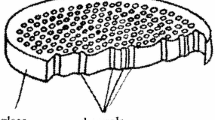Abstract
This paper describes a numerical development of image converters and intensifiers which incorporate an inverting electron optical system (EOS) and a microchannel plate (MCP) as an amplifier. The numerical design of the system includes calculation of the electrostatic field in the device, trajectories of electrons emitted from a photocathode, and determination of the modulation-transfer-function (MTF) which gives the objective estimation for the image quality.
Results of the numerical experiments are shown, and the EOS with optimized characteristics is developed. It provides the nearly flat image surface, determines the position of the surface of the best focus, minimizes the image distortion and reduces a noise factor of the MCP.
Similar content being viewed by others
References
Catchpole, C.E.: Measurement of the spatial frequency response of image devices. Adv. Electron. Electron Phys. 22(58), 425–433 (1966)
Clarke, J.A.: Measuring the MTF of channel image intensifiers. Acta Electron. 16(1), 33–41 (1973)
Emberson, D.L., Holmshaw, R.T.: The design and performance of an inverting channel image intensifier. Acta Electron. 16(1), 23–32 (1973)
Evdokimov, V.N., Kudrya, A.A., Tyutikov, A.M., Flegontov, Yu.A., Shymanska, A.V.: Current density distribution in the image of the multidyne’s channel. Radiotekh. Electron. 29, 390–392 (1984)
Hoenderken, T.H., Hagen, C.W., Barth, J.E., Kruit, P., Nutzel, G.O.: Influence of the microchannel plate and anode gap parameters on the spatial resolution of an image intensifier. J. Vac. Sci. Technol. B 19(3), 843–850 (2001)
Ilyin, V.P.: Numerical Methods for Solving Problems in Electron Optics. Nauka, Novosibirsk (1974)
Ivanov, V.: The image quality evaluation. Micro-channel amplifiers. The University of Chicago, Argonne and Fermilab, Large-area picosecond photo-detectors project, USA (2009). http://psec.uchicago.edu/Papers/Ivanov_image_quality.doc
Ivanov, V., Brezhnev, V.: New formulation of the synthesis problem in electron optics. Nucl. Instrum. Methods A 519, 117–132 (2004)
Ivanov, V., Kriklivyy, V.: Numerical algorithms for boundary problems with disturbed axial symmetry. Nucl. Instrum. Methods A 519, 96–116 (2004)
Khursheed, A.: The Finite Element Method in Charged Particle Optics. Kluwer Academic, Dordrecht (1999). Field solution for charged particle optics, pp. 25–44
Miroshnikov, M.M.: Theoretical Foundations of Electron—Optical Devices. Mechanical Engineering, Leningrad (1983)
Munro, E.: Computational techniques for design of charged particle optical systems. In: Orloff, J. (ed.), Handbook of charged Particle Optics, pp. 1–74. CRC Press LLC, Boca Raton (1997)
Schagen, P.: Electronic aids to night vision. Philos. Trans. R. Soc. A 269(1196), 233–263 (1971)
Schagen, P.: Image converters and intensifiers. J. Phys. E, Sci. Instr. 8, 153–160 (1975)
Shymanska, A.V.: Computational modeling of stochastic processes in electron amplifiers. J. Comput. Electron. 9, 93–102 (2010)
Shymanska, A.V., Evdokimov, V.N.: Effect of parameters of multidyne screen system on image quality. Sov. J. Opt. Technol. 52(7), 393–394 (1985)
Siegmund, O., Vallerga, J.V., Tremsin, A.S., Feller, W.B.: High spatial and temporal resolution neutron imaging with microchannel plate detectors. IEEE Trans. Nucl. Sci. 56(3), 1203–1209 (2009)
Tremsin, A.S., Feller, W.B., Dowing, R.G.: Efficiency optimization of microchannel plate neutron imaging detectors. Nucl. Instrum. Methods A 539(1–2), 278–311 (2005)
Vorobyov, Yu.V.: Dispersion figures in electrostatic immersion lenses. J. Tech. Phys. 26, 2269–2280 (1956)
Weisstein, E.W.: CRC Concise Encyclopedia of Mathematics. CRC Press, Boca Raton (1998). 1728/1740
Wiza, J.L.: Microchannel plate detectors. Nucl. Instrum. Methods A 162, 587–601 (1979)
Young, D.M.: Iterative Solution of Large Linear Systems. Dover, New York (2003)
Author information
Authors and Affiliations
Corresponding author
Rights and permissions
About this article
Cite this article
Shymanska, A. Numerical analysis of electron optical system with microchannel plate. J Comput Electron 10, 291–299 (2011). https://doi.org/10.1007/s10825-011-0365-8
Published:
Issue Date:
DOI: https://doi.org/10.1007/s10825-011-0365-8



